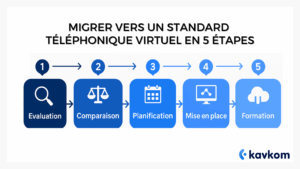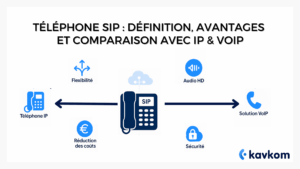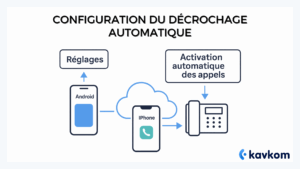Are you hesitating to migrate to VoIP telephony because switching from a landline to a new VoIP number seems complex and risky? Are you worried that call quality or integration with your current tools won’t be up to scratch, while at the same time looking to cut costs and gain flexibility? Is this really possible without heavy hardware and with a smooth transition?
In this guide, you’ll discover how to get a quality VoIP number and easily configure your VoIP phone to integrate a high-performance VoIP telephony solution. Here, we explain step-by-step how to reduce costs, optimize VoIP calls and transform your telephony system without heavy hardware. Read on for expert, practical advice.
Points to remember :
- A VoIP number works via the Internet, without the need for a fixed line or heavy equipment. It lets you make and receive calls from anywhere, with HD quality and a simple interface.
- The benefits for your company are tangible: costs reduced by up to 50%, total flexibility, and seamless integration with your business tools (CRM, support, etc.).
- Migration is carried out in 5 stages: needs assessment, choice of supplier, number portability, solution configuration, then testing and training.
- Integration with business tools is the key to boosting productivity: customer file that goes back to the call, automated reminders, real-time supervision…
- Kavkom stands out for its simplicity: rapid activation, CRM integration, human support and no-commitment packages tailored to SMEs and call centers.
What is a VoIP number?
We explain everything.
Definition and basic principles
A VoIP number (Voice over Internet Protocol) number is a telephone number that operates via the Internet. Unlike traditional telephone lines that use the copper (PSTN) network, VoIP uses the IP network to transmit voice as data.
In concrete terms, with a VoIP number :
- You can make and receive calls via a computer, smartphone or IP-enabled phone.
- It’s not tied to a fixed geographical line: you can use it anywhere, as long as you have an Internet connection.
- It can be assigned to a person, a team or a function (e.g. “customer support”).
This type of number also enables calls to be managed via an online interface, with advanced options such as recording, redirection, supervision, CRM integration…
All without heavy hardware or technical installation.
Differences from traditional telephony
| Traditional telephony | VoIP number |
|---|---|
| Physical fixed line | Operates over the Internet |
| Mandatory equipment (PBX, fixed stations) | No equipment required |
| Slow, localized deployment | Quick activation, accessible from anywhere |
| Low flexibility | Highly adaptable (mobility, multi-device) |
| Few integrations | Compatible with CRM, business tools, etc. |
In short: a VoIP number offers the same function as a traditional number, but with more freedom, more control and fewer constraints.
What are the advantages of VoIP telephony for your business?
Adopting VoIP telephony means choosing a system that’s more economical, more flexible and better adapted to the needs of modern businesses. Whether you run a call center or a sales team, the benefits are tangible.
Economic benefits
VoIP eliminates the costs associated with fixed lines, hardware and local maintenance. Thanks to the Internet, calls are handled over an existing infrastructure.
Benefits in figures :
- Reduces communication costs by 30-50% on average
Source : findstack.fr - Save up to 40% on local calls and 90% on international calls
Source : ceaseo.com - +20% productivity thanks to telephony integrated with business tools (automatic dialer, IVR, supervision)
Source : techesi.com
The result: higher-performance telephony… for much less.
Operational optimization and flexibility
VoIP is also transforming the way teams work on a day-to-day basis. It enables real-time management, better coordination and total adaptability.
- + productivity among contact center agents
- – of user complaints
- Reduced processing time
And also :
- Lower overall costs with VoIP in the cloud
- Immediate scalability: add or remove users with a single click
- Delegated maintenance = more freedom for the IT team
With VoIP, telephony becomes a performance tool, not a technical constraint.
Choosing the right VoIP service provider
Switching to VoIP is good. Choosing the right provider is even better. Quality of service, communications security and customer support make all the difference to successful adoption.
Essential selection criteria
Before choosing, ask yourself the right questions:
- Call quality: clear, uninterrupted calls, even under heavy network load.
- Security: communications encryption, RGPD compliance, data hosting in Europe.
- Customer support: responsive human assistance in French, available in the event of an incident.
- Flexible pricing: no-obligation offers that can be adjusted according to your workforce or specific needs.
- Easy to deploy: quick installation, no hardware required, with an intuitive interface.
According toArcep, 46% of French companies have already adopted VoIP, with 84% satisfied
On the other hand, 56% of users have encountered problems with their fixed Internet provider, proving that support quality remains a key criterion.
On the solution side, Kavkom stands out with :
- Quick commissioning (no hardware required)
- Native integration with leading CRMs
- Dedicated human support
- No-commitment packages, perfectly suited to call centers, sales teams and IT departments
Compare VoIP offers and packages
The VoIP market offers a wide range of packages. To compare :
- Check what’s included: unlimited calls? international calls? number of numbers?
- Beware of paying options: registration, reporting, supervision, CRM integration…
- Evaluate ease of implementation: the quicker it is to install, the faster you’ll be up and running.
With an average rating of 7.6/10 for fixed services, quality expectations are high.
Kavkom offers simple, scalable packages that are 100% designed for professionals: fast activation, full functionality, no hidden costs.
How do I obtain and configure a VoIP number?
Migrating to VoIP telephony is a strategic opportunity. But to make this transition a success, it’s essential to follow a clear methodology. Here are the 5 key steps to obtaining and configuring a VoIP number perfectly suited to your needs.
1. Assessing your needs
First and foremost, take the time to analyze your current situation and your objectives.
To evaluate :
- Call volumes: how many users? how many lines?
- Business objectives: cost reduction, improved customer service, supervision, etc.
- Network infrastructure: sufficient bandwidth? Quality of Service (QoS) in place?
A stable, well-configured connection is essential for smooth calls
Portability :
- Mobile number porting takes 1 to 3 working days
- A landline number can take from 2 to 10 days
Ask yourself the right questions:
- Do you need a multilingual system? CRM integration? an automatic dialer?
- Would you like real-time call statistics?
It is this phase that will determine the choice of the most appropriate solution.
2. Supplier selection and registration
Once you’ve defined your needs, choose a service provider that meets your technical and operational expectations.
Key points to consider:
- Guaranteed call quality
- Encryption and RGPD compliance
- Native integration with your business tools
- Responsive human support
Plan your migration:
Internet connection installation times depend on your operator. Activation begins once the connection is available.
- An ADSL connection takes 2 to 4 weeks on average
- Fiber optics, between 8 and 14 weeks
Some platforms, such as Kavkom, enable activation in just a few minutes if the infrastructure is ready.
Tip: register at least 2 months in advance to avoid unexpected interruptions or delays.
3. Number acquisition and portability
After registering, you can order a new number or port an existing one.
Regulatory deadline in France:
- Fixed number: portability within 7 working days, with max. 4-hour break
- Mobile number: portability within 1 working day, also with max. 4-hour outage
Source: arcep.fr
To succeed in this step :
- Check the administrative information associated with your number
- Coordinate portability with your old and new suppliers
- Warn your teams in advance of any temporary outage
4. Technical configuration and integration with your tools
Once the number has been activated, configure your VoIP interface and connect it to your business software.
Steps to follow :
- Create users, transfers, queues, answering machines
- Connect the platform to your CRM, support or ERP software via API or native connectors
- Activate advanced features: click-to-call, call scripting, supervision
With a well-designed cloud solution, like Kavkom, activation is possible in a matter of minutes in simple scenarios; more time is needed for complex or multi-site integrations.
5. Testing, training and deployment
Before taking the plunge, take the time to validate the implementation.
To do :
- Test internal and external calls
- Simulate different scenarios (opening hours, transfers, absences, etc.)
- Correct any technical bottlenecks
Form the teams:
- Short 30-minute sessions
- Access to user guides and videos
- Appoint an in-house technical consultant
Allow at least two weeks for a complete and gradual transition
Porting or advanced configuration requests can extend this timeframe, especially for complex or multi-branch systems.
Tips for successfully integrating your VoIP service
For the transition to a VoIP system to be a real performance driver, integration must be smooth, rapid and well supported. This means making the right technical choices and paying close attention to end-users.
Integration with business tools (CRM, API, etc.)
An effective VoIP solution needs to integrate seamlessly with your software environment. This automates workflows, saves time and improves the customer experience.
Best practices :
- Connect your VoIP to your CRM to automatically retrieve customer data when you call.
- Use open APIs to synchronize telephony with your internal tools or helpdesk.
- Integrate VoIP with your collaboration solutions (Slack, Teams, etc.) for smooth exchanges between teams.
Kavkom facilitates this integration with :
- Native CRM integration (Salesforce, HubSpot, Zoho…)
- An open API to connect the platform to all your tools
- A simple interface designed to be up and running in minutes
Training and support for users
Successful integration also relies on well-trained and well-supported teams.
Applicable tips :
- Organize a short, role-specific training session (support, sales, etc.).
- Provide tutorials or step-by-step guides
- Set up an in-house contact to help users
Above all, choose a supplier that offers personalized human support. If you get stuck, direct contact is better than an automated form.
Kavkom provides human support, with a dedicated, responsive and available team, to guarantee a rapid and worry-free adoption.
By combining seamless integration and targeted training, you’ll have every chance of making your VoIP transition a success and boosting your performance.
FAQ – Frequently asked questions
How do I use a VoIP number?
VoIP numbers are used via the Internet. All you need is a computer, smartphone or connected IP phone. You can make calls via a web interface, an application or a softphone. The number is accessible anywhere, even on the move.
What’s the best VoIP solution for businesses?
The best solution depends on your needs, but Kavkom stands out for its ease of installation, native CRM integration, no-obligation flexibility and responsive human support. It’s an ideal solution for call centers, sales teams and performance-driven businesses.
What are the three main advantages of VoIP numbers?
- Savings: up to 50% on communication costs.
- Flexibility: accessible from any Internet-connected device.
- Advanced features: recording, intelligent transfer, CRM integration, supervision.
Conclusion
Adopting a VoIP number and a cloud telephony solution is much more than a technical change: it’s a key step in modernizing your company’s communications.
By reducing costs, improving flexibility and simplifying integration with business tools, VoIP has established itself as an efficient, scalable solution, perfectly suited to the realities of call centers, sales teams or growing SMEs.
But successful migration depends on the right support. With Kavkom, you benefit from rapid installation, responsive human support, smooth CRM integration and a no-obligation solution designed to fit your real needs.
In short: VoIP is not just a tool, it’s a performance gas pedal.





